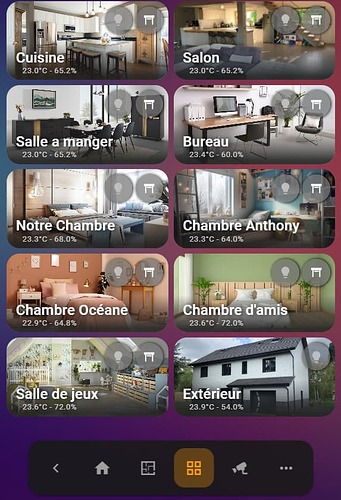Hello,
Home assistant ayant pas mal évolué depuis que je l’utilise (ça va bientôt faire 5 ans tout de même), je bascule peu a peu mon dashboard vers une version graphique et délaisse ma version yaml (plus compliquée à mainteniret a faire évoluer, même si elle ne bouge pas bcp).
La carte pièces ne n’étant pas très customizable, et ne répondant pas totalement a mes besoins, je me suis pas mal inspiré de ce que j’ai trouvé sur les forums, et particulièrement sur ce topic, voici donc ma petite pierre à l’édifice.
Le rendu:
Afin de mutualisé, j’utilise decluttering_card, j’ai donc mon template dans les yaml (modifier le tableau de bord → Menu du tableau de bord → Editeur de configuration):
Code du modèle commun a toutes les cartes
decluttering_templates:
dec_room2:
default:
light_id: null
cover_id: null
card:
type: custom:vertical-stack-in-card
cards:
- type: custom:mushroom-chips-card
chips:
- type: conditional
conditions:
- condition: state
entity: '[[light_id]]'
state_not: unavailable
chip:
type: template
entity: '[[light_id]]'
icon: mdi:lightbulb
icon_color: |
{% if is_state('[[light_id]]', 'on') %}
amber
{% else %}
disabled
{% endif %}
double_tap_action:
action: more-info
- type: conditional
conditions:
- condition: or
conditions:
- condition: state
entity: '[[cover_id]]'
state: open
- condition: state
entity: '[[cover_id]]'
state: closed
chip:
type: template
entity: '[[cover_id]]'
icon: |
{% if is_state(entity, 'open') %}
mdi:window-shutter-open
{% elif is_state(entity, 'closed') %}
mdi:window-shutter
{% else %}
mdi:window-shutter-alert
{% endif %}
double_tap_action:
action: more-info
alignment: end
card_mod:
style: |
:host {
display: block;
height: 57px !important;
margin-bottom: 7px;
}
ha-card {
padding: 8px;
--chip-height: 42px;
--chip-border-radius: 50%;
--chip-spacing: 5px;
--chip-background: rgba(114, 114, 114, 0.7);
--chip-box-shadow: black 1px 0 5px;
margin-bottom: 7px;
}
mushroom-conditional-chip:hover {
background-color: rgba(114, 114, 114, 0.8) !important;
border-radius: 50%;
}
- type: custom:mushroom-template-card
primary: '[[room]]'
secondary: >-
{{ states('[[temp]]') ~ '°C' if states('[[temp]]') not in
['unknown', 'unavailable', 'none', ''] else '' }} {{ ' - ' ~
states('[[humid]]') ~ '%' if states('[[humid]]') not in ['unknown',
'unavailable', 'none', ''] else '' }}
layout: horizontal
tap_action:
action: navigate
navigation_path: '[[navigation]]'
card_mod:
style:
.: |
ha-card {
background: linear-gradient(rgba(33, 33, 33, 0) 0%, rgba(33, 33, 33, 0.9) 90%);
--card-primary-font-size: 22px;
--card-secondary-font-size: 12px;
text-shadow: black 3px 0 8px;
padding-top: 0px;
padding-left: 4px;
height: 56px !important;
justify-content: flex-start
}
mushroom-state-info$: |
.secondary {
position: absolute;
top: 32px;
margin-left: 10px;
margin-bottom: -2px;
margin-top: 2px;
color: rgba(227, 227, 227, 0.85) !important;
min-height: 16px;
}
.primary {
position: absolute;
top: 12px;
overflow: visible !important;
}
card_mod:
style: |
ha-card {
background-image: url([[background]]);
background-position: center;
background-size: cover;
}
Puis dans le dashboard, j’utilise cette carte avec des variables:
Code de la carte de la cuisin
type: custom:decluttering-card
template: dec_room2
variables:
- room: Cuisine
- background: /local/images/pieces/cuisine.png
- temp: sensor.temp_cuisine
- humid: sensor.humid_cuisine
- navigation: areas-cuisine
- cover_id: cover.cuisine
- light_id: light.cuisine
grid_options:
columns: 6
rows: 2
Merci @BBE pour ce topic!
